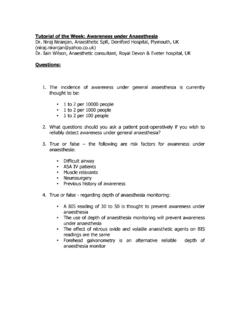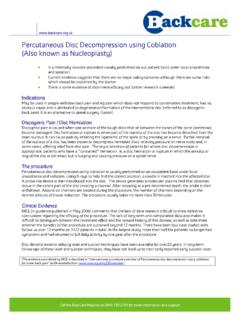Transcription of RESEARCH REPORT 314 - Health and Safety Executive
1 HSE. Health & Safety Executive Evaluation of manual handling tasks involving the use of carry chairs by UK ambulance personnel Prepared by the Health and Safety Laboratory for the Health and Safety Executive 2005. RESEARCH REPORT 314. HSE. Health & Safety Executive Evaluation of manual handling tasks involving the use of carry chairs by UK ambulance personnel Jeremy Ferreira MSc and Leanne Stanley Health and Safety Laboratory Harpur Hill Buxton Derbyshire SK17 9JN. The emergency carry chair is an important manual handling aid, used by UK ambulance services as the primary method for transporting patients up and down stairs and into the ambulance.
2 8 ambulance personnel performed 4 simulated handling tasks that commonly involved the use of the carry chairs: transporting a patient up and down stairs, lifting a patient into the back of an ambulance, wheeling a patient up a 10 ramp, and negotiating a kerb. Force, posture, and anthropometric data were combined into a biomechanical model to predict the risk of injury to the low back and the physical demands imposed on operators. Lifting the chair from a low level was found to expose the foot-end operator to a high risk of low back injury. High physical demands were also placed upon operators' arms.
3 When transporting patients down stairs, means of supporting the weight of the patient and chair on the stairs provides one promising control measure for reducing the risk of injury to the low back and upper body. However, when transporting patients up stairs the benefits are much smaller and the task remains physically demanding. Versatility was reported to be a key requirement for chairs, and several workplace factors, such as confined spaces, were found to limit situations in which more recently developed chairs could be utilised. This REPORT and the work it describes were funded by the Health and Safety Executive (HSE).
4 Its contents, including any opinions and/or conclusions expressed, are those of the authors alone and do not necessarily reflect HSE policy. HSE BOOKS. Crown copyright 2005. First published 2005. ISBN 0 7176 2962 7. All rights reserved. No part of this publication may be reproduced, stored in a retrieval system, or transmitted in any form or by any means (electronic, mechanical, photocopying, recording or otherwise) without the prior written permission of the copyright owner. Applications for reproduction should be made in writing to: Licensing Division, Her Majesty's Stationery Office, St Clements House, 2-16 Colegate, Norwich NR3 1BQ.
5 Or by e-mail to ii ACKNOWLEDGEMENTS. The Health and Safety Executive and Health and Safety Laboratory acknowledge the valuable support of the Ambulance Service Association during this work. Special thanks are offered to Westcountry Ambulance Service NHS Trust for the commitment they have shown to this RESEARCH . In particular, sincere thanks are offered to Steve McEvansoneya and Jason Parr of Westcountry Ambulance Service NHS Trust for their work in co-ordinating volunteer recruitment and to the volunteers themselves, some of whom travelled over 100 miles to participate in the study and contribute their valuable experience.
6 Finally, the Health and Safety Laboratory wish to acknowledge Captain Derek Jourdan and staff of the 243 (Wessex) Field Hospital in Derriford for providing an excellent testing facility for this study. iii iv CONTENTS. Executive Summary . vii 1 Introduction .. 1. Accident and Incident Data .. 1. Previous Work Practice Analyses of Patient Handling 1. Analyses of Recent Developments in Carry Chair Design .. 3. 2 Aims and Objectives .. 5. Aims .. 5. 5. 3 Methodology .. 7. Introduction .. 7. Safety Considerations / Ethical Approval .. 7. Experimental Design.
7 7. Pilot Study .. 12. Main Study .. 13. Biomechanical Approach Used in the 16. 18. 4 Results .. 19. Ascent and Descent of 19. Loading Patient into 34. Descent of a 40. 5 45. Effect of Chair Model on the Physical Demands of Stair Descent .. 45. Effect of Chair Model on the Physical Demands of Stair Ascent .. 47. Effect of a Ramp on the Physical Demands of Loading a Seated Patient into an Ambulance .. 49. Effect of Chair Model on the Physical Demands of Negotiating a Kerb .. 50. Development of Safe Systems of Work for Handling Seated Patients.
8 50. Limitations of the 51. 6 Conclusions .. 53. 7 Recommendations .. 55. 8 Appendices .. 57. Appendix A: Borg's (1982) RPE 57. Appendix B: Written Instructions Issued to Participants .. 58. Appendix C: Consent 59. Appendix D: Data Collection Sheet .. 60. Appendix E: Force Exertion Results .. 63. Appendix F: LMM Kinematic 65. 9 References .. 71. v vi Executive SUMMARY. OBJECTIVES. The emergency carry chair is an important manual handling aid, used by UK ambulance services as the primary method for transporting patients up and down stairs and into the ambulance.
9 Within the past few years, new designs in carry chair have emerged that claim to offer significant benefits by removing the need to support the full weight of the patient and chair. The purpose of this study was to evaluate patient handling tasks involving the use of emergency carry chairs. The aims of this study were: (1) To determine the musculoskeletal loads that operators are exposed to when performing these tasks; and (2) To investigate how carry chair designs and workplace factors impact on the Safety of handling procedures performed by ambulance personnel.
10 MAIN FINDINGS. When carrying a patient up and down stairs, the operator at the head-end position of the chair was found to exert more force than the operator at the foot-end position. However, the risk of low back injury appeared greatest at the foot-end position, as operator force exertion was combined with forward trunk flexion. In particular, the activity of lifting the chair from a low level exposes the foot-end operator to a high risk of low back injury. High physical demands were placed upon operators' arms when carrying a seated patient up and down stairs.
















